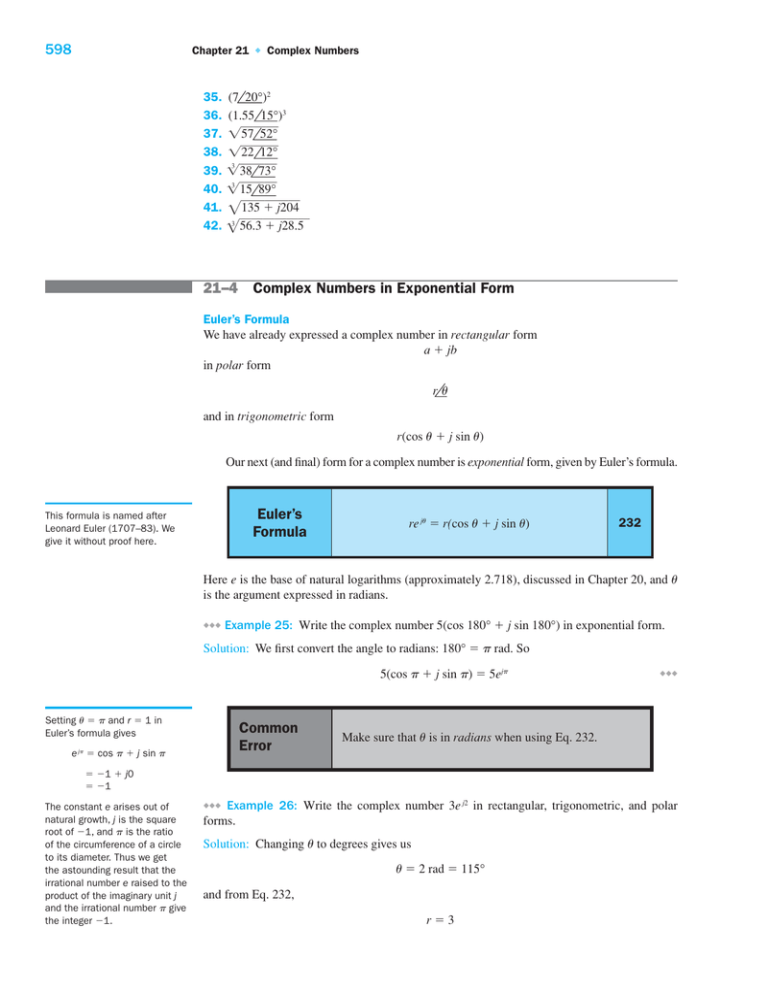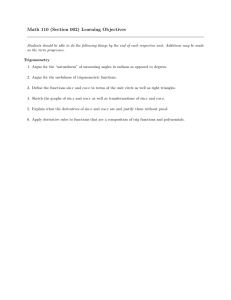598 21–4 Complex Numbers in Exponential Form Euler`s Formula
advertisement

598 Chapter 21 35. 36. 37. 38. 39. 40. 41. 42. ◆ Complex Numbers (7 20°)2 (1.55 15°)3 兹 57 52° 兹 22 12° 3 兹 38 73° 3 兹 15 89° 兹135 j204 3 56.3 j28.5 兹 21–4 Complex Numbers in Exponential Form Euler’s Formula We have already expressed a complex number in rectangular form a jb in polar form r and in trigonometric form r(cos j sin ) Our next (and final) form for a complex number is exponential form, given by Euler’s formula. Euler’s Formula This formula is named after Leonard Euler (1707–83). We give it without proof here. re j r(cos j sin ) 232 Here e is the base of natural logarithms (approximately 2.718), discussed in Chapter 20, and is the argument expressed in radians. ◆◆◆ Example 25: Write the complex number 5(cos 180° j sin 180°) in exponential form. Solution: We first convert the angle to radians: 180° rad. So 5(cos j sin ) 5ej Setting and r 1 in Euler’s formula gives Common Error e j cos j sin ◆◆◆ Make sure that is in radians when using Eq. 232. 1 j0 1 The constant e arises out of natural growth, j is the square root of 1, and is the ratio of the circumference of a circle to its diameter. Thus we get the astounding result that the irrational number e raised to the product of the imaginary unit j and the irrational number give the integer 1. Example 26: Write the complex number 3e j2 in rectangular, trigonometric, and polar forms. ◆◆◆ Solution: Changing to degrees gives us 2 rad 115° and from Eq. 232, r3 Section 21–4 ◆ 599 Complex Numbers in Exponential Form From Eq. 224, a r cos 3 cos 115° 1.27 and from Eq. 225, b r sin 3 sin 115° 2.72 So, in rectangular form, 3e j2 1.27 j2.72 In polar form, 3e j2 3 115° In trigonometric form, 3e j2 3(cos 115° j sin 115°) ◆◆◆ Products We now find products, quotients, powers, and roots of complex numbers in exponential form. These operations are quite simple in this form, as we merely have to use the laws of exponents. Thus by Eq. 29: Products ◆◆◆ r1e j1 · r2e j2 r1r2e j (1 2) 233 Example 27: (a) 2e j3 5e j4 10e j 7 (b) 2.83e j 2 3.15e j4 8.91e j6 (c) 13.5ej3 2.75e j5 37.1e j 2 ◆◆◆ Quotients By Eq. 30: Quotients r1e j1 r1 r2 e j (1 2) r2e j2 234 ◆◆◆ Example 28: 8e j5 (a) 2e j3 4e j2 63.8e j2 (b) 4.66ej3 13.7e j5 5.82ej4 (c) 0.592e j3 9.83e j 7 ◆◆◆ Powers and Roots By Eq. 31: Powers and Roots (re j)n r ne jn 235 600 Chapter 21 ◆◆◆ ◆ Complex Numbers Example 29: (a) (2ej3)4 16e j12 (b) (3.85ej2)3 57.1ej6 e j6 ej6 (c) (0.223ej3)2 20.1ej6 2 0.0497 (0.223) Exercise 4 ◆ ◆◆◆ Complex Numbers in Exponential Form Express each complex number in exponential form. 1. 2 j3 2. 1 j2 3. 3(cos 50° j sin 50°) 4. 12 14° 5. 2.5 6 6. 7 p cos j sin 3 3 7. 5.4 12 8. 5 j4 q Express in rectangular, polar, and trigonometric forms. 9. 5e j3 10. 7e j5 11. 2.2e j1.5 12. 4e j2 Operations in Exponential Form Multiply. 13. 9e j2 2e j4 15. 7e j 3e j3 17. 1.7e j5 2.1ej2 14. 8ej 6ej3 16. 6.2ej1.1 5.8ej2.7 18. 4ej7 3ej5 Divide. 19. 18ej6 by 6ej3 21. 55ej9 by 5ej6 23. 21ej2 by 7ej 20. 45ej4 by 9ej2 22. 123ej6 by 105ej2 24. 7.7ej4 by 2.3ej2 Evaluate. 25. (3ej5)2 27. (2ej)3 21–5 26. (4ej2)3 Vector Operations Using Complex Numbers Vectors Represented by Complex Numbers One of the major uses of complex numbers is that they can represent vectors and, as we will soon see, can enable us to manipulate vectors in ways that are easier than we learned when studying oblique triangles. Take the complex number 2 j3, for example, which is plotted in Fig. 21–7. If we connect that point with a line to the origin, we can think of the complex number 2 j3 as representing a vector R having a horizontal component of 2 units and a vertical component of 3 units. The complex number used to represent a vector can, of course, be expressed in any of the forms of a complex number.



